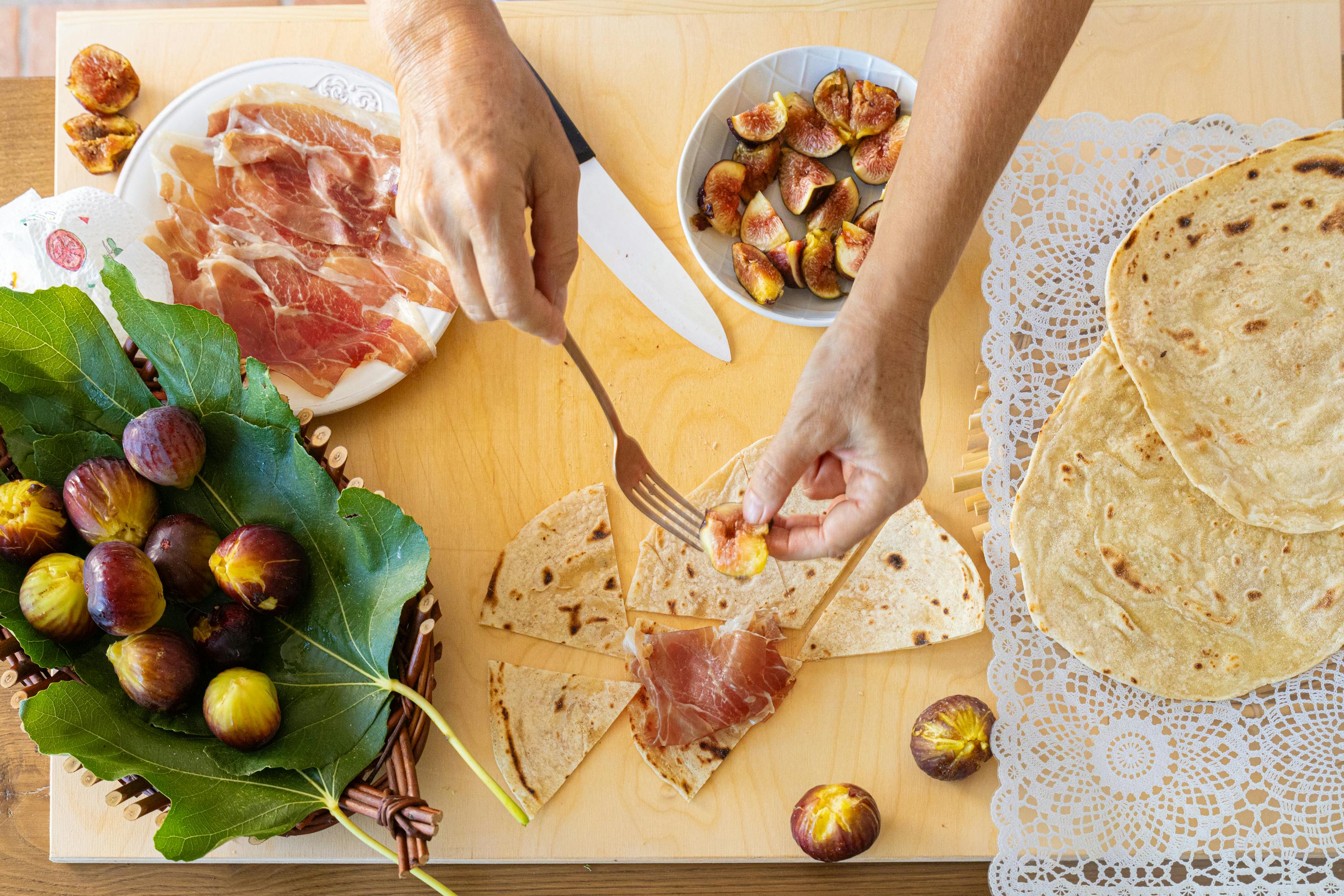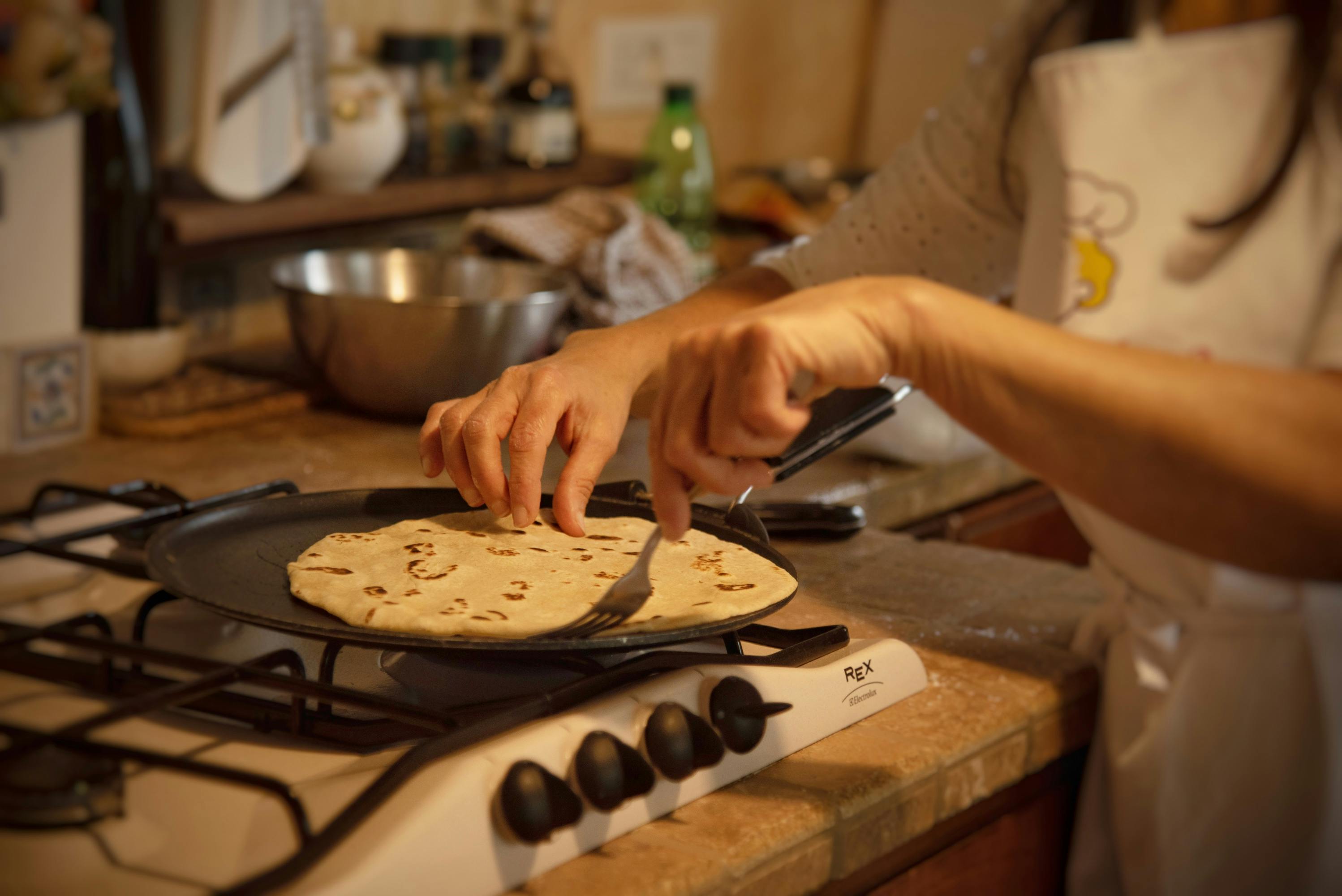

The Piadina Romagnola or Piada, made with simple ingredients that have given birth to the queen of Romagna gastronomy: flour, water, lard or extra virgin olive oil, baking soda or yeast, salt and water, to the point that, in 2014, the European Union listed it as a trademark with a protected geographical indication (IGP).
Celebrated by poets and musicians, from Giovanni Pascoli who decanted it in his poem "La Piada" to Raoul Casadei, a pillar of Romagna music, and Samuele Bersani who sang "Have you thought any more about that project of exporting the Piadina Romagnola?"; it is an icon of taste and simplicity and anyone who takes a trip to Romagna cannot avoid tasting it at least once because... one Piadina leads to another! If the Piadina Romagnola has been so successful there must be a reason!
When was the Piadina born?
Born in ancient times, it has its roots in rustic and peasant culture and over time has turned into the most beloved and sought-after food by all. The origins of Piadina Romagnola are to be found around 1200 B.C., on the tables of the poor. The first traces come from far away, from the times of the ancient Etruscans, a folk who used to bake doughs made of water and cereal flour. This custom was later greatly appreciated by the Romans because of its great practicality, quick baking and validity as a substitute for bread.
During the Middle Ages, it then began to spread also among the peasantry because it was considered a simple and inexpensive food, as it was a good alternative to bread and could be made from other grains that were not taxed.
What is the Piadina Romagnola?
La pida se parsot la pis un po ma tot, goes a Romagna saying, which translated means, "Everyone likes piada with ham."
North of Rimini, Cesena, Forlì and Ravenna, people eat Piadina, from Rimini to Cattolica they eat Piada. But what is the difference? Piadina Romagnola Rimini-style is wider and thinner with a thickness of up to 3 mm and a diameter of 23 to 30 cm, it turns out to be softer and more flexible while Piadina Romagnola is smaller, with a thickness of 4 to 8 mm and a diameter of 15 to 25 cm, and that is why it turns out to be stiffer and more compact.
Tasty, appetizing and practical, thanks to its highly versatile nature it is difficult not to find the ideal combination because there are so many possible pairings! Perfect to be eaten on any occasion: a lunch, a dinner, an aperitif with friends, a quick snack or an outdoor picnic.
We leave you with two recipes by Cesarina Patrizia from Rimini with which you can prepare and stuff as you like traditional Piadine Romagnole suitable for any occasion. One involves the use of lard and the other extra virgin olive oil.
Let your imagination run wild!

Piadina Romagnola
Learn how to prepare the queen of Romagna gastronomy: tasty, practical and versatile in its nature!
Ingredients
- Piadina romagnola with lard:
- Ingredients for 6 piadine:
- 500 g of 0 flour
- 80 g of lard
- 200 g of water at room temperature
- 8 g of salt
Piadina romagnola with extra virgin olive oil: - Ingredients for 6 piadine:
- 500 g of 0 flour
- 80 g of extra virgin olive oil
- 220 g of water
- 8 g of salt
Method
For the piadina romagnola with lard:
- Pour the flour onto a pastry board and add the salt, mixing well;
- Form a hole in the center of the flour with your hands and add the lard, starting to dissolve it with a little water and helping yourself with a fork;
- Gradually add the rest of the water and begin to incorporate the flour a little at a time, mixing with your hands;
- Knead vigorously for about 10 minutes;
- Divide the dough into 6 equal parts weighing about 130 g each and form balls;
- Cover the balls with plastic wrap and let them rest in the refrigerator for at least 30 minutes;
- Take the balls back from the refrigerator and roll them out thinly on a pastry board with the help of a rolling pin, using a little flour to keep them from sticking;
- Heat a nonstick pan or frying pan and cook each piadina for a few minutes on both sides until they puff up and have golden patches.
For the piadina romagnola with extra virgin olive oil: - Pour the flour onto a pastry board and add the salt, mixing well;
- Form a hole in the center of the flour with your hands and add all the extra virgin olive oil and slowly the water, trying to mix the mixture well;
- Start incorporating the flour from the ends toward the center, helping yourself with a fork;
- Knead vigorously for at least 10 minutes;
- Divide the dough into 6 equal parts and form balls;
- Cover the balls with plastic wrap and let them rest in the refrigerator for at least 30 minutes;
- Take the balls out of the refrigerator and roll them out thinly on a pastry board with the help of a rolling pin, using a little flour to keep them from sticking;
- Heat a nonstick pan or frying pan and cook each piadina for a few minutes on both sides until they puff up and have golden patches.
Why not try making the piadina sfogliata yourself?
If you love piadina, we recommend trying the piadina sfogliata (flaky piadina) as well. Typical of the Marche region, specifically Pesaro, flaky piadina (also called crescia sfogliata) is made by rolling the dough into a thin layer, then folding and rolling it several times to create delicate layers.

